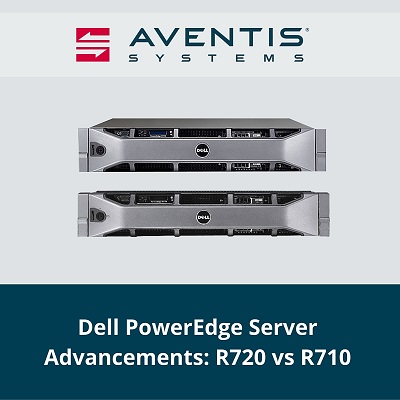Dell PowerEdge Server Advancements: R720 vs R710
Have you ever asked yourself: "Do I really need the newest generation server? Why is the latest and greatest better? What exactly am I paying for?"
We can provide a simple comparison of the Dell PowerEdge R720 and PowerEdge R710 servers answering common questions from IT professionals. Take a look at this quick breakdown of the Dell PowerEdge R720 and R710 product specifications to find out what you’re actually getting in both models.

Processors
Similar to other newer generation servers, the Dell PowerEdge R720 upgraded to a newer CPU family. The R720 supports the Intel Xeon E5-2600 product family, an upgrade from the Intel Xeon 5500 and 5600 product lines supported by the PowerEdge R710. What does this mean exactly? Intel’s E5-2600 processors have up to 20MB cache and up to 8 cores versus the 5500 and 5600 processors which max out at 12MB Cache and 6 cores. These 8-core processors are ideal for increased security, I/O innovation and network capabilities, and overall performance.
Memory
While the Dell PowerEdge R710 supports up to 288GB max memory with 18 DIMM slots, the R720 boasts up to 768GB max memory and a whopping 24 DIMM slots. The R720 can also take a newer faster DDR3 memory than the R710. Now that everyone is turning to virtualization, the need for more memory has rapidly increased. Do you really need 768GB of memory, though? Here’s a good rule of thumb to follow: you should generally allocate 2GB memory per virtual machine (VM).
Storage
If you're looking for immense storage capabilities, the R720 might be for you. The R720 supports up to 32TB maximum internal storage, including up to eight 3.5" hard drives or sixteen 2.5" hard drives. The R710 also supports a high level of internal storage maxing out at 18TB. That includes up to six 3.5" hard drives or eight 2.5” hard drives. Either option, R720 or R710, provides support for 6Gb/s SAS, SATA, and SSD drives.
RAID Controller
With more internal storage capabilities comes the need to upgrade internal RAID controllers. While the R720 can support the PERC H310, H710, and H710p internal RAID controllers, the R710 is limited to the PERC 6/i, H200, H700, and SAS 6/iR internal RAID controllers. A limitation of PERC 6/i and SAS/iR controllers is the 3Gb/s interface. The difference to note among the other internal RAID controllers is the RAID levels supported. All RAID levels are supported by the PERC H710p, H710, and H700, whereas the others have limitations.
Remote Management
Another difference between the R720 and R710 is the remote management featured. The R710 comes standard with the iDRAC6 Express whereas R720 comes standard with iDRAC7 Express. iDRAC 7 is license-based and features embedded tools, console integration, and simplified remote access.
We hope this overview of the PowerEdge R720 and R710 provided useful insights to help you decide on your next hardware purchase. Check out our recorded webinar "Advances in Server Technology: What Every IT Buyer Should Know" to learn more about the application uses for each server generation.